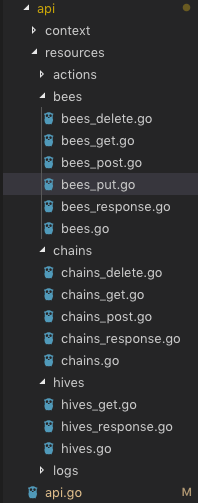Overview
看一下作者本人的注释
// Package bees is Beehive's central module system.
beehive 非常有趣的在于各逻辑的解耦设计,这不仅让本身功能操作简单,也让扩展变得关注点少了很多,只需要一点学习成本就可以扩展自己的 beehive
首先解释一下 bee hive 中 的概念
bee 代表的是我们常见的 Worker 也就是说,实际的行为是由这些 小蜜蜂执行的。他们就类似于采蜜的工人,采集到了之后统一放回来处理
hive 是蜂房,也就是我们常见的 WorkerPool 不同的是,她更像一个 Facotry ,什么意思呢?她可以创建专属的 bee 。在极少的配置下,比如只需要配置上一个 token 即可。就可以生成一只 bee 专门针对某一种蜜工作了。
chain 又是什么? chain 就是链接事件与处理的工具,我们认为 bee 采回蜜是一个事件,总不可能采回来啥都不干吧。针对不同的 蜜 我们就有不同的反应,就有不同的 action
比如某人的 blog 更新了 ,rss bee 接收到了之后飞回来,我们就可以再要求 email bee 把这其中的信息通过邮件发给我们或者我们想发给的人。
这就需要 chain 来联系 event 和 action 了
Landscape
API Register
成组的 API 实现了 Resource 接口注册到 Container 的路由 Route 中。
帮助理解
在文件中写好了 作者 实现的 Handle 的实现来注册 http 请求
API 只是供调用,逻辑重点在 bees 这个包里的实现。
Bee
首先是有的接口
// BeeInterface is an interface all bees implement.type BeeInterface interface {// Name of the beeName() string// Namespace of the beeNamespace() string// Description of the beeDescription() string// SetDescription sets a descriptionSetDescription(s string)// Config returns this bees configConfig() BeeConfig// Options of the beeOptions() BeeOptions// SetOptions to configure the beeSetOptions(options BeeOptions)// ReloadOptions gets called after a bee's options get updatedReloadOptions(options BeeOptions)// Activates the beeRun(eventChannel chan Event)// Running returns the current state of the beeIsRunning() bool// Start the beeStart()// Stop the beeStop()LastEvent() time.TimeLogEvent()LastAction() time.TimeLogAction()Logln(args ...interface{})Logf(format string, args ...interface{})LogErrorf(format string, args ...interface{})LogFatal(args ...interface{})SetSigChan(c chan bool)WaitGroup() *sync.WaitGroup// Handles an actionAction(action Action) []Placeholder}
和他的基础实现
// Bee is the base-struct to be embedded by bee implementations.type Bee struct {config BeeConfiglastEvent time.TimelastAction time.TimeRunning boolSigChan chan boolwaitGroup *sync.WaitGroup}
这里需要注意的是 Run 接口,在 Base-Struct Bee 中该方法 是空的实现,因为 Run 是 Bee 的生命周期开始处,是自动开始的。
WebBee 实现
简单的看某一个实现即可
// WebBee is a Bee that starts an HTTP server and fires events for incoming// requests.type WebBee struct {bees.Beeaddr stringeventChan chan bees.Event}
可以很清楚的指导,这个 WebBee 中的 eventChan 正是通知的地方,也就是上文所说的 Chain 的开始处。注意的是由于松耦合的设计,任何 Bee 都可以成为 Chain 上的一环,只要它能触发事件。或者监听事件。
func (mod *WebBee) Run(cin chan bees.Event)
// Run executes the Bee's event loop.func (mod *WebBee) Run(cin chan bees.Event) {mod.eventChan = cinsrv := &http.Server{Addr: mod.addr, Handler: mod}l, err := net.Listen("tcp", mod.addr)if err != nil {mod.LogErrorf("Can't listen on %s", mod.addr)return}defer l.Close()go func() {err := srv.Serve(l)if err != nil {mod.LogErrorf("Server error: %v", err)}// Go 1.8+: srv.Close()}()select {case <-mod.SigChan:return}}
同时 WebBee 也有一个方法 ServeHTTP 来实现 http.Handle 来处理请求。
这里也就是前文所说的 注册的那些 API 的部分来源,每一个 bee 自身实现的自动注册暴露给外界调用。
func (mod *WebBee) ServeHTTP(w http.ResponseWriter, req *http.Request)
Event
package:beehive/bees/event.go
刚才讲到了 触发事件 event 的 WebBee 实现,现在我们来看 event 的实现
实际上是通过 这个函数实现的
// handleEvents handles incoming events and executes matching Chains.func handleEvents() {for {event, ok := <-eventsIn···bee := GetBee(event.Bee)(*bee).LogEvent()···go func() {defer func() {if e := recover(); e != nil {log.Printf("Fatal chain event: %s %s", e, debug.Stack())}}()execChains(&event)}()}}
省略了 日志部分。可以看到 handleEvents 通过接受通道里的 event,并检查 event 中的 Bee 作为 标志找到对应的 Bee 唤醒。
这里我们可以看到 最后进入了 Chains 中执行,即上文所说的 Chain 将 Event 和 Action 链接了起来,让 Bee 之间能够协作。
chain
package:beehive/bees/chains.go
chain 中实际上是调用 Actions 通过下面的 execActions 函数
for _, el := range c.Actions {action := GetAction(el)if action == nil {log.Println("\t\tERROR: Unknown action referenced!")continue}execAction(*action, m)}
我们来看看 Action 的执行。
Action Exec
package: beehive/bees/actions.go
actions 既可以运行设置中的 options 也可以直接在 运行函数中传入需要运行的 optionsfunc execAction(action Action, opts map[string]interface{}) bool
Summary
整个执行逻辑是如此了,其他还有一些
- 日志处理:用于跟踪 bee 和 hive 的情况
- Config:保存配置文件,每一次启动可以重新放飞以前的 Bee 们
- Signal:beehive 拦截了一些 Signal 的 Kill 等信号来执行优雅退出,避免了 Config 等的丢失。
- Run Flag:执行的附带参数,设定 Beehive 整个应用的监听端口和版本配置。

